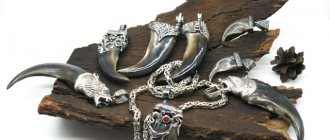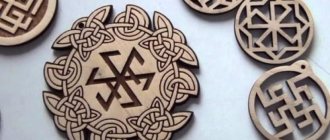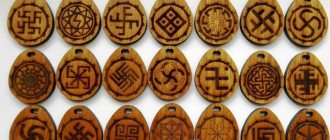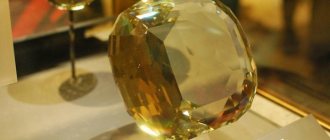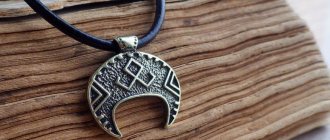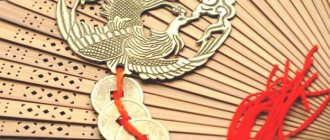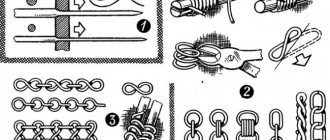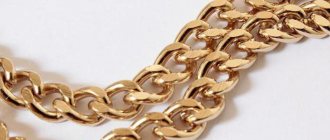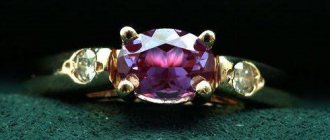Slavic amulets are ready to tell us a lot of interesting things about how our ancestors perceived their existence. Our Slavic ancestors worshiped the inexorable power and strength of nature, fearing the destructive influence of dark forces. To protect against the influence of entities from the dark side, special amulets were created that also protected against the evil eye, envy and malevolent energy messages of a magical nature.
“Belobog and Chernobog” is a painting by artist Vsevolod Ivanov. The Slavs revered both deities equally.
The meaning of some Russian folk amulets has been lost over time, but most of them have come to us in the form in which our ancestors used them. This rich heritage of Slavic symbolism allows us not only to satisfy curiosity, but also to better understand our ancestors, finding a connection with them through the depths of centuries.
History of Slavic amulets
The meaning of Slavic symbols cannot be reduced to one thing. Some of the signs combine others or personify the entire Slavic people and the knowledge they have accumulated. However, each of the ancient symbols has its own interpretation.
Some are worn only by men, others are designed for women, and there are also universal ones. It is important to take into account not only this feature, but also the age of the person who will use them. For example, signs of Perun or other warlike gods should not be worn by children. And some women's amulets, such as Makosh, are not very suitable for young, inexperienced girls.
“Perun’s Arrival on Earth”, artist Vsevolod Ivanov. Our forefathers believed that one could receive the patronage of the god of thunder and thunder by using one of his symbols as a talisman.
The history of Slavic amulets is multifaceted and interesting; it is very closely intertwined with the culture of our ancestors. The pagan cult that flourished in those days led to the appearance of symbols dedicated to certain deities and even holidays. Solar symbols, most often worn in the form of body jewelry, were considered the most popular.
Amulets were not always decorations - protective signs were also applied to household items and even to livestock.
What were amulets made of in Rus'?
One of the most common questions related to ancient Russian amulets is the material for their manufacture.
Used to create:
- various metals (gold, silver, copper or bronze);
- wood;
- bones and teeth of animals or their horns;
- clay;
- threads (linen, cotton and even silk);
The choice of material is important, but not of paramount importance. Some people deceptively believe that Slavic amulets made of gold have greater magical potential than a similar item made from simple raw materials. It's a delusion. The correct selection of a talisman, its activation and faith in success will bring a much more fruitful result than an emphasis on demonstrating status.
When choosing the type of wood for making a talisman, the gender of the person for whom it was intended was taken into account.
In the old days there was not such an abundance of materials as there is now. The Slavs made objects with protective properties from what was at hand. This may be considered a disadvantage, but such limitations also brought some benefits.
The most common raw material was silver. Silver amulets are universal - this metal rarely causes rejection on a physical or energetic level. In addition, according to Slavic beliefs, silver scared away evil spirits. This is what contributed to the spread of protective objects made from this metal in ancient times.
We often came across talismans made of copper, but this metal is considered to be feminine. As for wooden amulets, the choice of the type depended on who it was intended for. Like ancient symbols, the Slavs similarly divided all trees into female and male. The type of tree was chosen based on this.
The purpose of the amulet should also be taken into account. The material for an individual amulet was selected taking into account gender. And family ones could also be made from wood with a masculine character. Protective signs found in everyday life or on clothing were very often made from threads. The needle was not approved in this case - it could “pierce” the protective field. Sometimes a needlewoman could not do without such a tool, but she was not allowed to leave the needle in the embroidery during the process or when it was interrupted.
The craftswoman making the thread talisman must be in good health and good spirits. She must not be distracted from work so as not to interfere with her concentration, otherwise she will not be able to put her energy into the amulet, thereby charging it.
Amulets for men and women
Slavic amulets were rarely universal, which once again confirms the need to follow the main rule - to approach the choice of amulets seriously. Most often they were classified as male or female and were used only by a representative of a certain gender.
However, the meaning of amulets among the Slavs tended to change. The essence of the ancient sign did not change completely, but it could exhibit new properties. This mainly happened when women wore male signs. Some life situations may require representatives of the fairer sex to have masculine strength that is not typical for them. In this case, amulets helped to withstand the trials of fate and protect one’s family if there was no man nearby capable of fulfilling this mission.
But Slavic men practically did not use women's amulets. This is due to the fact that most of them are aimed at developing femininity, helping in family matters and motherhood. While men needed to gain strength, courage, determination and negotiation skills.
Traditionally masculine signs include:
- Ax of Perun;
- Gromovik;
- Kolyadnik;
- Shield of Perun;
- Hammer of Svarog;
- Doukhobor;
- Vseslavets.
Listed above are only the most common types of ancient Russian amulets for men. In Slavic culture, a man was the head of the family, a protector - it is precisely towards the successful performance of these functions that the action of most male symbols is aimed. In addition, such amulets can make a man physically stronger.
Women's Slavic amulets are aimed at preserving the family hearth. They help maintain youth and beauty, bear a baby, protect family members from evil people and dark forces.
Among them:
- Ladinets;
- Lada Star;
- Lunnitsa;
- Woman in labor;
- Ognevitsa;
- Makosh.
The Slavic talisman Rozhanitsa for women will help the expectant mother bear a healthy child.
Prayers
From time immemorial, prayers and amulets have been considered the best shield against all adversity. Many are confident that by turning to the Lord and the saints with words, they can protect themselves and their family from envious people and enemies. It will also help in protecting your home, which is also often exposed to negative energy.
To protect your native walls, you can put a strong amulet. But before you do this, you need to perform a cleansing ritual that will help you get rid of negative programs.
Prayers also protect us from people who wish evil at work. They create a barrier that no witchcraft can penetrate. Before leaving home for work or school, you need to go to the window and say the following prayer out loud:
This is the most powerful protective prayer that will protect you from any evil action. It doesn't matter how many times you read it. The main thing is to believe that the Lord will help you cope with any difficulties and will provide protection for your loved ones from any misfortune.
There is another prayer, which is called the amulet of the three angels from all problems, which has similar properties as the one described above. It must be read only after the “Our Father.” The words are as follows:
Charms for children
Slavic symbols and amulets intended for women were usually divided into three types: for girls, girls and adult women. Girls were supposed to look for a betrothed in order to start a family with him and raise a new generation, and the woman was supposed to maintain the already acquired family happiness in order.
Little girls who did not yet have a family could not be considered full-fledged guardians of the hearth. But as they were supposed to become such in the future, mothers desperately tried to protect their family members from the evil eye, damage and other witchcraft.
The purpose of Old Russian amulets for boys was reduced to almost the same functions for adult men. But taking into account the young age, less aggressive symbols and patrons were selected to help gradually develop the vital qualities of every man - courage, determination, bravery and eloquence.
Jewelry was considered the main type of individual amulets. But it was not customary to give them to children under three years of age. Until this time, signs were applied to clothing in the form of embroidery. Special toys were also common. Slavic girls often wore the symbol Lelnik or Ladinets as a pendant, and boys - Kolyadnik, Molvinets or Rodimich.
The Slavs applied amulets on children's clothes in the form of embroidery.
Photo
Next in the photo you can see what the Slavic swastika looks like:
Such a talisman will protect you from many troubles:
The Slavic swastika is also depicted with rounded ends:
A lot depends on the correctness of the symbol:
The direction of the rays plays an important role:
Universal symbols
The meaning of Slavic amulets is not always clearly related to the feminine or masculine principles. Some ancient Slavic signs seem to be on the verge between these two opposites. At first it may seem that universal Slavic symbols are easier to use. But in reality everything is much more complicated.
Only a few of them can truly be used equally by men and women. These include:
- Alatyr,
- Molvinets,
- Kolovrat,
- Defeat the grass.
However, the latter is worn to a greater extent by women, taking care of their health, which is necessary for procreation. At the same time, Molvinets is often classified as a male symbol, although it does not develop masculine qualities, but promotes the development of communication skills.
Such versatility of Slavic symbols requires taking into account the character of the future owner. For example, Molvinets is more likely to harm than benefit overly sociable individuals, and some of Perun’s attributes can make a person overly aggressive.
Age should also be mentioned. Certain universal Slavic talismans used by women and men require belonging to the “correct” age category. Thus, the Solar Cross symbol can only be worn by people of the older generation who have extensive life experience.
Making a talisman using runes
People preferred to make protective amulets with runes with their own hands. Signs were applied to certain surfaces. It was believed that they should be natural: stone, wood, bone.
Before you start creating a protective talisman, you should clear your thoughts of all evil intentions and perhaps meditate. After this, you can begin the ritual. The runic sign must be applied in its literal meaning, following the rules for its drawing. When performing the ritual, they think about their desire and imagine its implementation.
A separate symbol or an entire formula cannot be burned. To apply, take a needle to scratch out a sign, or a pencil to draw a blank, and then outline it with paint. The dye is taken natural, it is better if it is henna. After completion of production, the rune is activated using the element.
Old Russian and Scandinavian runes are still popular today. Most often, symbols are used to attract luck in life. Formulas and individual talismans work if the operator follows all the rules for creating and working with amulets.
Amulets for family and home
Slavic ancient amulets, intended to protect the clan, were typically divided into two types. The first was responsible for the safety of the home from the encroachments of dark forces and unkind people, and the second attracted and maintained a favorable environment in the house.
Some Slavic protective symbols could be located both inside and outside the house. A horse horseshoe would be such a striking example. Despite the fact that it is not a native Slavic-Aryan talisman, the Slavs quite often used it in everyday life.
Hanged with its horns down over the entrance to the house, the horseshoe had protective powers. To attract wealth, the horse “trail” was hooked in the hallway, always with the arms up. This article will tell you how to hang a horseshoe correctly.
Another traditional protector of the house is considered to be the Slavic symbol Alatyr. Applied to household items, this sign acted as a shield, protecting the house from negative energy, helping residents gain wisdom.
What does the Veda sign mean?
Veda is the personification of true Vedic knowledge, giving comprehension of all natural laws. You can turn to her for an answer to a question in any difficult life situation. She is surrounded by sacred animals - a bear, a deer and a swan.
- The swan is a symbol of impeccable purity, allowing you to find harmony and perfection.
- The bear symbolizes good nature and inner strength, protecting from trouble and misfortune, endowing with wisdom.
- Deer is the personification of beauty and grace, serving as a messenger of miracles that show the way to the intended goals.
Various types of amulets among the Slavs
The amulets and amulets of ancient Rus' were used to achieve several purposes. The Slavs greatly revered their family. They tried in every possible way to help and protect other family members. This was expressed not only in actions, but also in the making of special protective items for sisters, brothers, daughters, sons, wives or husbands.
There was also another type of amulets - protective. Such objects were designed to protect against visible evil in the person of unfriendly neighbors and various entities that took the side of Chernobog - merman, mermaids, ghouls and other evil spirits.
A variety of materials were used to create such protective artifacts. There are also plenty of forms that they can take:
- body jewelry;
- knots on clothes and jewelry or as the latter (nauz);
- amulets dolls;
- tattoos;
- embroidery on interior items, clothing and hats;
- tableware painting;
- herbal collections hung in bunches in the home;
- depiction of ancient symbols on houses;
Below we will look at the main ones.
Knots talismans
Another popular type of Slavic amulets is nauz. Slavic women were famous not only for their love of weaving braids, but also knots. This special magic required special skills. The knots had to be braided strictly in a certain order. These ancient Russian amulets symbolized different things. Some were for good luck, others for the evil eye, and others for attracting love.
Weaving nauzs is one of the techniques of Slavic magic. Our forefathers believed that woven knots could help in various aspects of life.
Ancient Slavic doll amulets
A doll is considered one of the classic Slavic home amulets that help protect the family and everyone living in it. Our ancestors believed that unclean spirits could inhabit the faces of dolls - that is why all rag dolls made as talismans and amulets do not have faces. They can be individual or general in nature.
Newborns and their mothers were given a Nurse doll. Children also received the Kuvadok doll amulet as their first toy. They made several of them, always an odd number, and then hooked them over the cradle. There was also a doll to protect against diseases - the Fever doll, as well as one that helped someone who was already sick to recover - the Herbalist. For married couples, a Lovebird doll amulet was made to help protect personal happiness.
“Lovebirds” dolls are a family amulet.
Slavic tattoos
Quite little is known about Russian amulets worn directly on the skin. The only fact that remains certain is that a common motif played out in the tattoos of our forefathers was the scene of victory in the battle between the thunderer Perun and the Serpent.
Nowadays, almost everything that is in any way connected with the ancient Slavs is used as a Slavic tattoo-amulet - images of gods or all sorts of mythical creatures, scenes of battles, solar symbols and even Slavic runes. The meaning of tattoos often even remains a mystery to its wearer, which should under no circumstances be allowed if you do not want to ruin your life by improperly interfering with fate.
Body jewelry
Slavic jewelry with amulets were and remain the most convenient way to wear a talisman. Jewelry, unlike tattoos, can be removed or replaced without any problems if there is a need to interact with another symbol. It is also easy to clean and recharge. Especially if it is made of metal.
Most often, the Slavs made amulets in the form of a pendant. This method was considered equally suitable for men and women. The latter preferred a lighter material - wood, while men usually chose metal. Such an amulet was not easy to lose or spoil in battle.
Less common, but still in demand, were bracelets and rings. It was difficult to apply Slavic signs on small, elegant women's rings. They were only suitable for applying runic symbols. Therefore, rings were often worn by male representatives.
Runic symbols
Amulet pendants with runic symbols.
Many Old Slavic amulets, in addition to sacred symbols, bore the image of runic symbols. It would be wrong to consider Slavic runes as a common alphabet, despite the fact that they were often used to write the names of Slavic gods. These signs carried a special meaning that can be interpreted both individually and together, combining runes into words or entire spells from words.
Almost every rune, like other Slavic symbols, had a double meaning - it depended on the position of the sign, upright or inverted.
A fairly common use of Slavic runic symbols was the application of signs on weapons as a talisman, as well as their similar use in embroidery.
Embroidery as a talisman
Previously, needlework was one of the few entertainments available to women. Based on this, the amulets of the Slavs were embodied in embroidery. In those days, people wore clothes made of simple, natural fabrics, so decorating with embroidery was easier to do than with modern materials.
Embroidery on Slavic clothing was not purely decorative. Usually there was a secret meaning hidden in the patterns. This could be a wish for happiness and health, an appeal to the gods with a request for protection, or protective spells against everything evil. Some household items were also decorated with special embroidery - pillows and blankets, towels and small decorative pillows, and even entire paintings, which were then framed and hung on the wall.
Slavic amulets in the form of embroidery are still popular in our time, giving the outfits of modern fashionistas a special charm.
Main criteria
Many people confuse the purpose of a talisman and an amulet. The purpose of the amulet is to protect the owner from troubles, illnesses, the evil eye and theft. Talisman - attracting luck, luck and prosperity.
The main thing is not which amulet is abstractly the strongest in the world, but which one will be the strongest for you. The power of any magical thing lies in faith, because the more a person puts into it, the stronger it becomes.
Talismans that were made by relatives, father or mother, children, sisters, brothers are especially powerful. Marriage is a non-family relationship, so protective items given by the other half do not have much power. The exception is married couples who live in harmony and mutual understanding.
The ideal talisman for intercession is wedding rings.
Nowadays, wedding rings have various decorations; stones are often inserted into them or engravings are made. But according to ancient regulations, wedding rings should be even and smooth, without precious stones. If there are any decorations on them, the ring loses energy. It is not recommended to remove them, as this may affect the protection of the couple from the evil eye.
